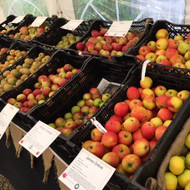Knowing exactly when to pick your fruit isn’t as straightforward as it may appear. Even the professionals get it wrong. I know in these turbulent times this will certainly class as a first world problem, but one of more infuriating little moments in the week is to buy a supposedly ripe and ready to eat avocado, only to get home and discover you could knock nails in with it. So how are we going to ensure that our home grown produce is picked at its absolute best, ripened to perfection and ready to enjoy or store for future use? Well, there are some basic guidelines about what to look for, and armed with this knowledge we can be certain to harvest at the right time. After all, this is the highlight of the year for the fruit gardener - finally getting the chance to savour the results of months of care and attention. Let’s not mess it up at the final moment!
There are many factors at play which can alter the best date for picking by many weeks. The first and most important is the specific variety – with apples, for example the earliest such as Summer Golden Pippin may be ready in late July, whereas a late season variety such as Winston may need until late October to be picked. If you know which variety you have planted, a quick search on the internet will give you a rough idea of what stage of the season it is likely to be ripe. If you have inherited a tree, I’m afraid the first year will be a bit of a trial run, but hopefully you will have enough knowledge after reading this to have an educated guess!
The weather will also have an impact on the timing – so the same tree will not crop at the exact same time every year. Crucially, it is the weather in late winter/ early spring which has the most effect, as this determines when the tree comes into blossom. The period from blossom to pick date is generally the same, whether we have a scorcher of a summer or (the more normal) washout. So, if Spring arrives late, even weeks of hot summer sun will not speed up the ripening process. Geographical position will also make a difference – gardeners on the south coast of the UK will be picking fruit several weeks ahead of their more northerly cousins.
Even on the same tree, not all the fruit will ripen at exactly the same time. Normally the fruit at the top of a tree and on the south facing side will ripen several days or even a week or two before the fruit on the inside or shady side. Trained trees such as espalier or fans will ripen much more evenly, but otherwise for a free standing tree expect to have to pick at least twice to get perfectly ripened fruit.
When to pick also depends a little on how you want to use the fruit. If you are eating fresh, try and leave the fruit on as long as possible, to get as many sugars as possible to form and produce the richest flavour. If on the other hand you want to try and store the fruit through the winter months, pick very slightly underripe. The extra starch will help the fruit keep better.
Apples:
To test if an apple is ready, cup the fruit in the palm of your hand and twist through 90 degrees. If it comes off easily, taking the stalk but no part of the branch (and definitely no leaves!) it’s ripe and ready to pick. If not, leave it on the tree and leave for a few days and try again. Always use the palm of your hand rather than fingertips, to avoid bruising the fruit.
Pears:
For pears, you employ a similar technique, but instead of twisting you lift the fruit up until it is upside down. Again, if it comes away easily with no tugging or wrestling, the fruit is ready to be picked.
Pears are notoriously tricky to get right – although some of the early varieties such as Louis Bonne are soft to the touch and ready to eat straight away, many of the mid and late season varieties will still be hard and practically inedible even if ready to come off the tree. Store in the fridge, or in a very cool shed or garage and bring them in to the house a few at a time to ripen in the fruit bowl. Pay attention though, as they can go from underripe to a soft inedible mush in quite a short period. Ralph Waldo Emerson said “There are only ten minutes in the life of a pear when it is perfect to eat”. He was exaggerating a little, but there is nothing quite as infuriating as seeing months of careful nurturing be fit only for the compost heap if you take your eye off the ball!
Plums and gages:
Pick these when they start to become soft to the touch. Leave them on the tree for as long as you dare (wasps and birds can be a pest as the fruit starts to become ready, so net or fleece if you can). Plums ripen even more unevenly than apples, so you may have to pick over the course of a couple of weeks.
Storing
Some varieties of fruit just will not store well. In general, it tends to be the early cropping apples and pears, and most of the stone fruit. They have thinner skins, higher juice and sugar content, and so if kept as whole fruit at room temperature they will ‘go off’ within a week or two. If you want to keep the fruit without processing it in some way, the best option is to store in the salad drawer of your fridge. At around 4 degrees Celsius, you should be able to keep even very early varieties of apple such as Discovery for 3 to 4 weeks, before they become soft and ‘floury’.
Late season apples, and some winter pears such as Glou Morceau can be very successfully stored as fruit, using the traditional method of wrapping in newspaper and storing in trays. There are several tips to help ensure the fruits store for as long as possible. Firstly, only store perfect fruit. Anything with skin blemishes, or windfalls must be used straight away and not put with the clean fruit, otherwise the mould and brown rot spores on the damaged fruit will quickly spread to the good ones. Choose a storage place which is cool, dry and dark. A garage is ideal - constant cool temperatures are a must. Inspect the fruit at regular intervals and discard any that are deteriorating.
One of the main reasons that the Bramley cooking apple is so ubiquitous is that it stores for such a long time. Until the advent of the home freezer, apples had to be stored in tact as fruit, and Bramley's will keep until April or may the following year. These days, however, freezing fruit is often a much quicker and simpler method of preserving fruit for later use.
For cooking apples, simply stew them with a little water and sugar as normal and leave to cool in the pan. Then transfer into freezer bags, label and pop them in the bottom of your freezer. I’d highly recommend this method rather than the traditional newspaper and box method - not least because it frees you up to grow all sorts of early varieties which have a tremendous flavour but just don’t store too well.
Another great method is to freeze in thin slices. This works well for dessert apples which due to their higher sugar content don’t break down to a fluff on cooking. Peel, core and thinly slice the fruit. In order to stop the fruit browning, keep a Small bowl of water with a good dash of lemon juice added nearby and dunk the fruit as soon as it is sliced. You can also use pineapple juice/lemon juice mixture, which has the bonus of giving an added depth of flavour to the apple slices.
Simply place on a baking sheet line with parchment, and place in the quick freeze part of your freezer. After a couple of hours when the slices are frozen through, take out of the freezer and transfer into a freezer bag. Label and return to the freezer.
Of course, there are many other ways of preserving your harvest, from juicing and jamming through to bottling and drying. And lets not forget that perennial favourite, steeping in alcohol! Make it your mission this Autumn to try at least one new way of storing your fruit harvest - and when the stores are full of fruit which has been flown halfway around the world, you can enjoy the produce of your own garden.

